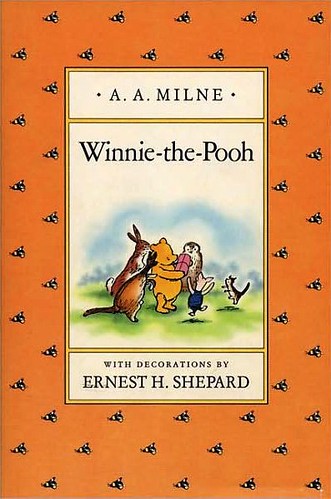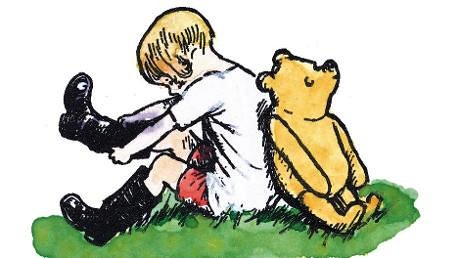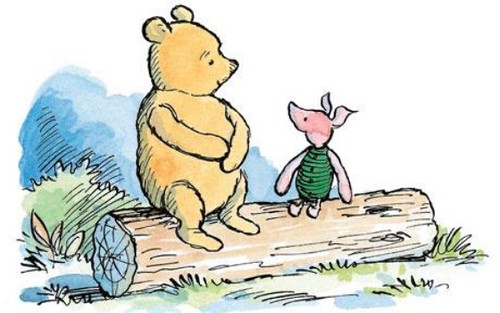 Winnie-the-Pooh, also known as Pooh Bear, is an anthropomorphic teddy bear that fumbles through life’s adventurous accompanied by his fellow anthropomorphic friends and the young English boy, Christopher Robin. The first collection of stories featuring Pooh bear were Winnie-The-Pooh published in 1926, and The House at Pooh Corner published in 1928. Milne’s stories have been translated into many languages and published around the world. The most famous translation was Alexander Lenard’s Latin translation Winnie ille Pu. In 1961 Daphne Milne released the stories’ copyright licenses to Disney. Since 1966 Disney has released numerous animated productions starring Winnie the Pooh and his friends, including a television series and four feature-length movies; The Tigger Movie, Piglet’s Big Movie, Pooh’s Heffalump Movie, and Winnie-The- Pooh.
Winnie-the-Pooh, also known as Pooh Bear, is an anthropomorphic teddy bear that fumbles through life’s adventurous accompanied by his fellow anthropomorphic friends and the young English boy, Christopher Robin. The first collection of stories featuring Pooh bear were Winnie-The-Pooh published in 1926, and The House at Pooh Corner published in 1928. Milne’s stories have been translated into many languages and published around the world. The most famous translation was Alexander Lenard’s Latin translation Winnie ille Pu. In 1961 Daphne Milne released the stories’ copyright licenses to Disney. Since 1966 Disney has released numerous animated productions starring Winnie the Pooh and his friends, including a television series and four feature-length movies; The Tigger Movie, Piglet’s Big Movie, Pooh’s Heffalump Movie, and Winnie-The- Pooh. 
With the popularity of the books, characters, movies, and merchandise it is hard to find a child in America who does not know Pooh bear. Pooh’s legacy in popular culture is world-wide. He is so popular in Poland and Budapest that streets have been named after him. Amazingly, though, Winnie-The-Pooh has faced hard criticism since its publication in 1926. To this day, Milne’s stories sit at number 22 on the American Library Association’s top 100 banned books list. Like Alice-in Wonderland, Winnie-the-Pooh has been challenged by religious groups because the animal characters can speak and act on the same level as their human counterpart Christopher Robin. As shown in many book challenging cases the idea of talking animals has been cited as an abomination in the site of God.
 Most fans of Winnie-The-Pooh will fondly remember Pooh Bear’s closest friend Piglet. Piglet is a nervous, and generally timid, pink pig that often finds his courage in the nick of time to save his dear friends from one catastrophe or another. Unfortunately, Piglet seems to have rubbed some readers the wrong way. In the United Kingdom, Winnie-The-Pooh along with Charlottes Web and The Little Pigs nursery rhyme were banned from public schools because the talking pig characters might offend Muslim and Jewish students who abstain from pork as part of their religions. Fortunately in recent years, the Muslim Council of Britain formally requested an end to the “well intentioned but misguided policy” and for all the materials to be returned to classroom shelves.
Most fans of Winnie-The-Pooh will fondly remember Pooh Bear’s closest friend Piglet. Piglet is a nervous, and generally timid, pink pig that often finds his courage in the nick of time to save his dear friends from one catastrophe or another. Unfortunately, Piglet seems to have rubbed some readers the wrong way. In the United Kingdom, Winnie-The-Pooh along with Charlottes Web and The Little Pigs nursery rhyme were banned from public schools because the talking pig characters might offend Muslim and Jewish students who abstain from pork as part of their religions. Fortunately in recent years, the Muslim Council of Britain formally requested an end to the “well intentioned but misguided policy” and for all the materials to be returned to classroom shelves.
The most interesting case of Winnie-The-Pooh’s banning happened in 2009 in Russia. In a report from the Wall Street Journal “Russia’s Justice Ministry placed the book on a list of banned material and labeled it pro-Nazi because a depiction of Pooh bear wearing a swastika was discovered among the personal possessions of a known political extremist. If one extremist was in possession of a Nazi Pooh, the local courts concluded, then it stood to reason that others may follow suit” (bannedbooks.world.edu). So, to this day Russian children cannot have access to the Milne tales without strict consequences.
To read more on why Winnie-The-Pooh has been challenged and banned throughout the world visit this site. And remember to check back next week to find out why the many beloved fairytales by the Brothers Grimm have been challenged and deemed far too violent for young audiences.
You can visit the Banned Children’s Books exhibit at the Department of Special Collections and University Archives located on the 5th floor of McFarlin library, we are open Monday-Friday, 8-5.
